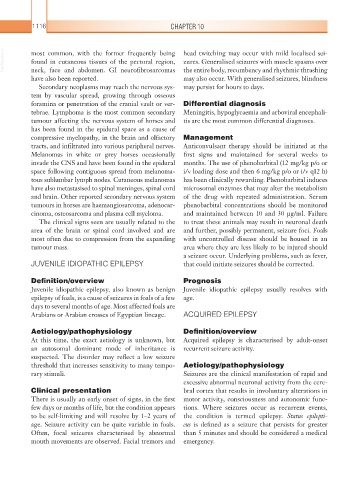Page 1141 - Equine Clinical Medicine, Surgery and Reproduction, 2nd Edition
P. 1141
1116 CHAPTER 10
VetBooks.ir most common, with the former frequently being head twitching may occur with mild localised sei-
zures. Generalised seizures with muscle spasms over
found in cutaneous tissues of the pectoral region,
neck, face and abdomen. GI neurofibrosarcomas
have also been reported. the entire body, recumbency and rhythmic thrashing
may also occur. With generalised seizures, blindness
Secondary neoplasms may reach the nervous sys- may persist for hours to days.
tem by vascular spread, growing through osseous
foramina or penetration of the cranial vault or ver- Differential diagnosis
tebrae. Lymphoma is the most common secondary Meningitis, hypoglycaemia and arboviral encephali-
tumour affecting the nervous system of horses and tis are the most common differential diagnoses.
has been found in the epidural space as a cause of
compressive myelopathy, in the brain and olfactory Management
tracts, and infiltrated into various peripheral nerves. Anticonvulsant therapy should be initiated at the
Melanomas in white or grey horses occasionally first signs and maintained for several weeks to
invade the CNS and have been found in the epidural months. The use of phenobarbital (12 mg/kg p/o or
space following contiguous spread from melanoma- i/v loading dose and then 6 mg/kg p/o or i/v q12 h)
tous sublumbar lymph nodes. Cutaneous melanomas has been clinically rewarding. Phenobarbital induces
have also metastasised to spinal meninges, spinal cord microsomal enzymes that may alter the metabolism
and brain. Other reported secondary nervous system of the drug with repeated administration. Serum
tumours in horses are haemangiosarcoma, adenocar- phenobarbital concentrations should be monitored
cinoma, osteosarcoma and plasma cell myeloma. and maintained between 10 and 30 µg/ml. Failure
The clinical signs seen are usually related to the to treat these animals may result in neuronal death
area of the brain or spinal cord involved and are and further, possibly permanent, seizure foci. Foals
most often due to compression from the expanding with uncontrolled disease should be housed in an
tumour mass. area where they are less likely to be injured should
a seizure occur. Underlying problems, such as fever,
JUVENILE IDIOPATHIC EPILEPSY that could initiate seizures should be corrected.
Definition/overview Prognosis
Juvenile idiopathic epilepsy, also known as benign Juvenile idiopathic epilepsy usually resolves with
epilepsy of foals, is a cause of seizures in foals of a few age.
days to several months of age. Most affected foals are
Arabians or Arabian crosses of Egyptian lineage. ACQUIRED EPILEPSY
Aetiology/pathophysiology Definition/overview
At this time, the exact aetiology is unknown, but Acquired epilepsy is characterised by adult-onset
an autosomal dominant mode of inheritance is recurrent seizure activity.
suspected. The disorder may reflect a low seizure
threshold that increases sensitivity to many tempo- Aetiology/pathophysiology
rary stimuli. Seizures are the clinical manifestation of rapid and
excessive abnormal neuronal activity from the cere-
Clinical presentation bral cortex that results in involuntary alterations in
There is usually an early onset of signs, in the first motor activity, consciousness and autonomic func-
few days or months of life, but the condition appears tions. Where seizures occur as recurrent events,
to be self-limiting and will resolve by 1–2 years of the condition is termed epilepsy. Status epilepti-
age. Seizure activity can be quite variable in foals. cus is defined as a seizure that persists for greater
Often, focal seizures characterised by abnormal than 5 minutes and should be considered a medical
mouth movements are observed. Facial tremors and emergency.

